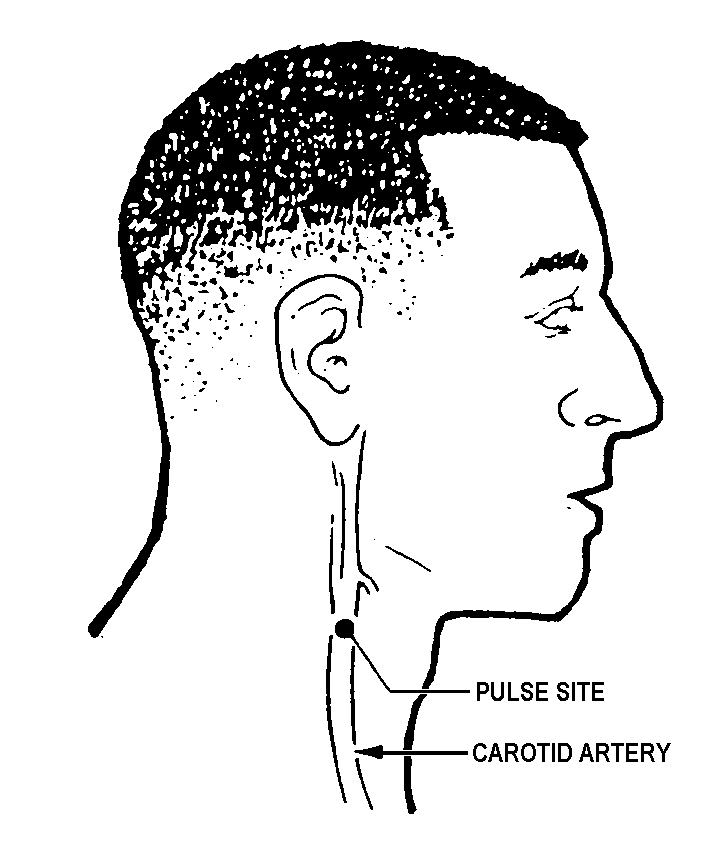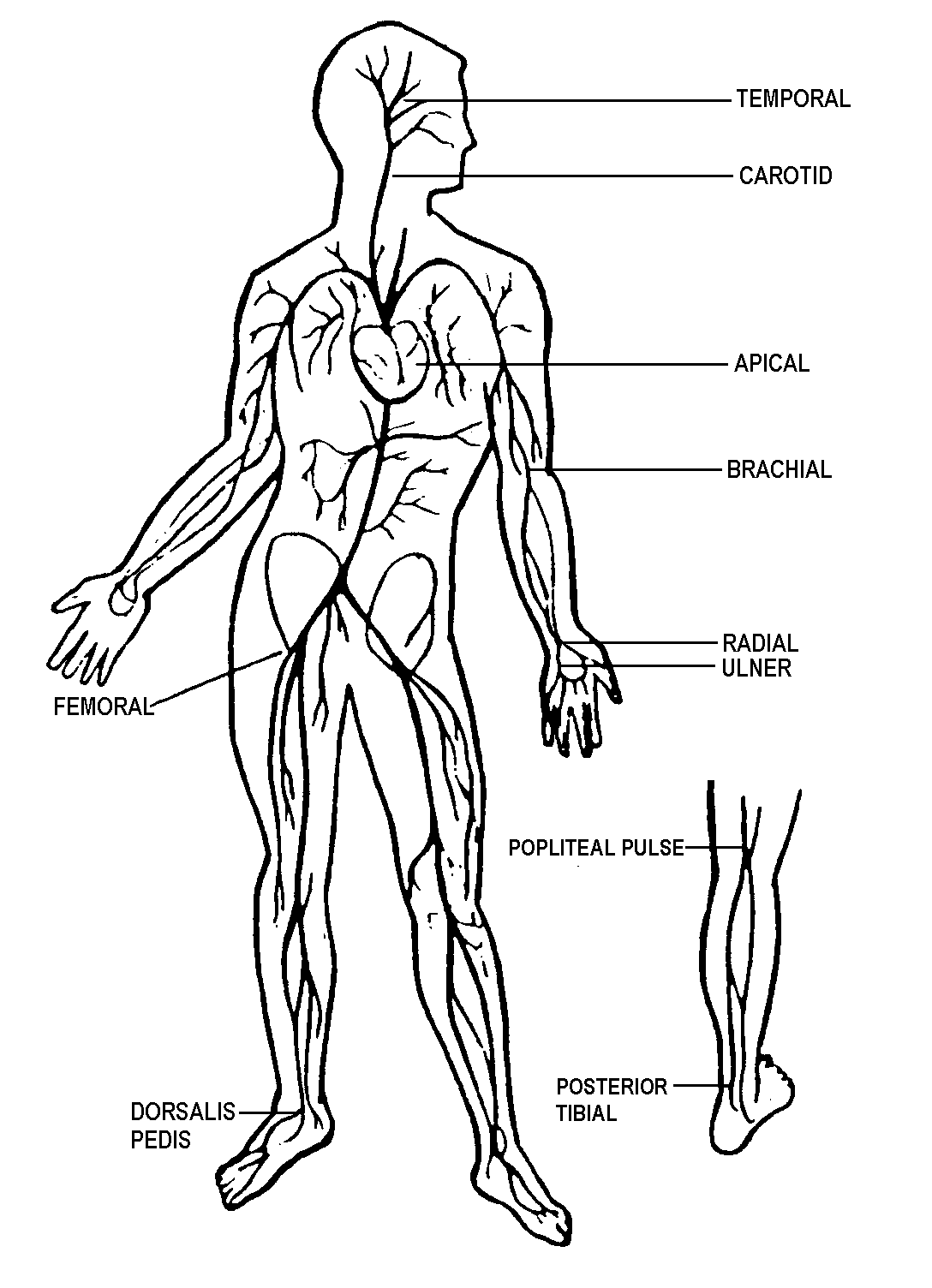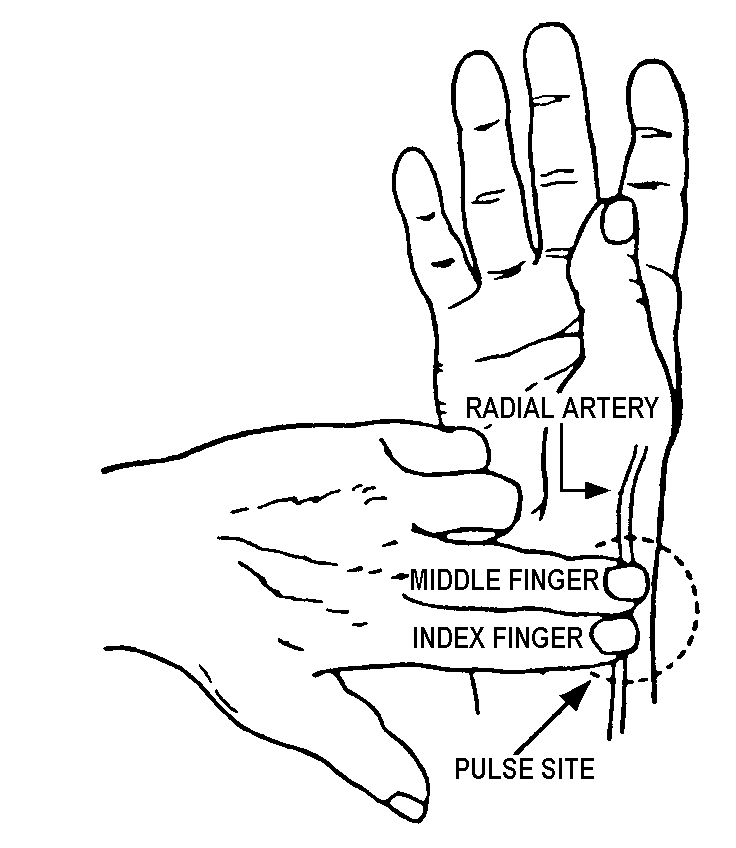
LESSON 18
MEASURE AND MONITOR A CASUALTY'S PULSE
TASK
Determine a casualty's pulse rate and describe the characteristics of the pulse.
CONDITIONS
Given a simulated casualty and a timepiece with a second hand.
STANDARD
Score a GO on the performance checklist.
REFERENCES
STP 21-1-SMCT, Soldier's Manual of Common Tasks: Skill Level 1.
FM 21-11, First Aid for Soldiers.
STP 8-91-SM, Soldier's Manual: CMF 91: General Medical Tasks.
18-1. INTRODUCTION
Pulse is used to measure the casualty's heartbeat rate. When the heart contracts (pumps blood), a pulse is created in the arteries which can be felt and counted. The pulse is a result of a brief expansion of the artery that occurs with each heartbeat. The normal adult heart rate ranges from 60 to 80 beats per minute with an average rate of 72.
18-2. LOCATE THE PULSE SITE
The pulse can usually be felt (palpated) most easily at a location where an artery crosses a bony area. There are several locations at which a casualty's pulse is taken (pulse beats counted). Three commonly used pulse sites are found at the carotid (neck) artery, the radial (wrist) artery, and the femoral artery. The name of the artery is used when referring to the pulse site. For example, the pulse is taken at the carotid artery is called the carotid pulse.
a. Carotid Pulse Site
The carotid pulse is taken at a groove along the casualty's larynx (Adam's apple) containing a carotid artery. There are two (right and left) carotid arteries. The right carotid artery is located in a groove on the right side of the larynx and the left carotid artery is located in a groove on the left side of the larynx. Either artery can be used to take the casualty's carotid pulse. The carotid pulse site is a preferred location because the carotid artery is a central artery and is usually accessible without removing the casualty's clothing.
WARNING
DO NOT APPLY PRESSURE TO BOTH CAROTOID ARTERIES AT THE SAME TIME

FIGURE 18-1. CAROTID PULSE SITE
b. Radial Pulse Site
The radial pulse is located on the inside of the wrist near the base of the thumb. Do not use the back of the wrist. Either wrist can be used.

FIGURE 18-2. RADIAL PULSE SITE
 c. Other Pulse Sites
c. Other Pulse Sites
FIGURE 18-3. OTHER PULSE SITES
The temporal pulse is felt at the temple near the ear. The brachial pulse is felt on the inside of the elbow. The femoral pulse is felt in the groin area. The popliteal pulse is felt behind the knee. The dorsalis pedis pulse is felt on top of the foot. A pulse may also be felt directly over the heart on the left side of the casualty's chest. This pulse is called the apical pulse.
18-3. TAKE THE CASUALTY'S PULSE
Changes in a casualty's pulse directly reflect changes in his heart rate. Making an accurate assessment of the pulse is important.
NOTE: "Normal" pulse rate and strength may vary from individual to individual.
Palpate the Pulse Site
Place the tips of your index and middle fingers over the pulse site and press gently. Too much pressure on the artery could interfere with blood circulation and stop the pulse.
CAUTION: Do not place your thumb on the pulse site. The thumb has its own pulse. If you use your thumb, you may be taking your own pulse rather than the casualty's pulse.

FIGURE 18-4. PALPATING THE RADIAL PULSE SITE
Count the Pulse Beats for One Minute
Using a clock with a second hand, count the pulse for one full minute.
A normal pulse rate for an adult when resting is from 60 to 80 beats per minute. The average is 72 beats per minute.
A higher than normal pulse rate (a resting pulse rate of over 80 beats per minute) can be caused by several factors including shock, bleeding, excessive heat, dehydration, fever, pain, emotions, and vigorous activity (such as running).
Tachycardia is an abnormal condition that exists when the casualty's pulse rate is over 100 beats per minute.
A lower than normal pulse rate (a resting pulse rate of less than 60 beats per minute) can be caused by several factors, including heart disease and medications. A pulse rate below 60 may also occur in a soldier who is physically fit.
A pulse rate of less than 50 beats per minute is called bradycardia.
Classify the Strength of the Pulse
A regular pulse is easy to feel and has even beats of good force.
A bounding pulse is one that is easily detected due to the exceptionally large amount of blood being pumped with each heartbeat.
A weak pulse is difficult to detect due to a decreased amount of blood flowing through the arteries, usually due to bleeding or shock.
An absent pulse cannot be detected. Lack of a detectable pulse may indicate that the artery is blocked or injured.
CAUTION: If no pulse or only an indistinct pulse is felt at the radial or posterior tibial site, palpate the carotid pulse site. The carotid pulse site is less likely to be blocked or severely weakened due to trauma or disease. If the carotid pulse cannot be found, try to feel the apical pulse.
18-4. MONITOR THE CASUALTY'S PULSE
Continue to take the casualty's pulse periodically as needed. Report abnormal readings or any significant changes in rate and/or strength to medical personnel.
Performance checklist follows.